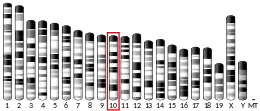TAAR8
Trace amine-associated receptor 8 is a protein that in humans is encoded by the TAAR8 gene.[5][6][7] In humans, TAAR8 is the only trace amine-associated receptor that is known to be Gi/o-coupled.[8]
| TAAR8 | |||||||||||||||||||||||||
|---|---|---|---|---|---|---|---|---|---|---|---|---|---|---|---|---|---|---|---|---|---|---|---|---|---|
| Identifiers | |||||||||||||||||||||||||
| Aliases | TAAR8, GPR102, TA5, TAR5, TRAR5, TaR-5, TaR-8, trace amine associated receptor 8 | ||||||||||||||||||||||||
| External IDs | OMIM: 606927 MGI: 2685995 HomoloGene: 77586 GeneCards: TAAR8 | ||||||||||||||||||||||||
| |||||||||||||||||||||||||
| |||||||||||||||||||||||||
| |||||||||||||||||||||||||
| |||||||||||||||||||||||||
| Orthologs | |||||||||||||||||||||||||
| Species | Human | Mouse | |||||||||||||||||||||||
| Entrez | |||||||||||||||||||||||||
| Ensembl | |||||||||||||||||||||||||
| UniProt | |||||||||||||||||||||||||
| RefSeq (mRNA) | |||||||||||||||||||||||||
| RefSeq (protein) | |||||||||||||||||||||||||
| Location (UCSC) | Chr 6: 132.55 – 132.55 Mb | Chr 10: 24.09 – 24.09 Mb | |||||||||||||||||||||||
| PubMed search | [3] | [4] | |||||||||||||||||||||||
| Wikidata | |||||||||||||||||||||||||
| |||||||||||||||||||||||||
In humans, molecular modelling and docking experiments have shown that putrescine fits into the binding pocket of the human TAAR6 and TAAR8 receptors.[9]
G protein-coupled receptors (GPCRs, or GPRs) contain 7 transmembrane domains and transduce extracellular signals through heterotrimeric G proteins.[supplied by OMIM][7]
See also
References
- GRCh38: Ensembl release 89: ENSG00000146385 - Ensembl, May 2017
- GRCm38: Ensembl release 89: ENSMUSG00000100186 - Ensembl, May 2017
- "Human PubMed Reference:". National Center for Biotechnology Information, U.S. National Library of Medicine.
- "Mouse PubMed Reference:". National Center for Biotechnology Information, U.S. National Library of Medicine.
- Lee DK, Nguyen T, Lynch KR, Cheng R, Vanti WB, Arkhitko O, et al. (September 2001). "Discovery and mapping of ten novel G protein-coupled receptor genes". Gene. 275 (1): 83–91. doi:10.1016/S0378-1119(01)00651-5. PMID 11574155.
- Lindemann L, Ebeling M, Kratochwil NA, Bunzow JR, Grandy DK, Hoener MC (March 2005). "Trace amine-associated receptors form structurally and functionally distinct subfamilies of novel G protein-coupled receptors". Genomics. 85 (3): 372–85. doi:10.1016/j.ygeno.2004.11.010. PMID 15718104.
- "Entrez Gene: TAAR8 trace amine associated receptor 8".
- Mühlhaus J, Dinter J, Nürnberg D, Rehders M, Depke M, Golchert J, et al. (November 2014). "Analysis of human TAAR8 and murine Taar8b mediated signaling pathways and expression profile". International Journal of Molecular Sciences. 15 (11): 20638–55. doi:10.3390/ijms151120638. PMC 4264187. PMID 25391046.
- Izquierdo C, Gómez-Tamayo JC, Nebel JC, Pardo L, Gonzalez A (January 2018). "Identifying human diamine sensors for death related putrescine and cadaverine molecules". PLOS Computational Biology. 14 (1): e1005945. Bibcode:2018PLSCB..14E5945I. doi:10.1371/journal.pcbi.1005945. PMC 5783396. PMID 29324768.
Further reading
- Borowsky B, Adham N, Jones KA, Raddatz R, Artymyshyn R, Ogozalek KL, et al. (July 2001). "Trace amines: identification of a family of mammalian G protein-coupled receptors". Proceedings of the National Academy of Sciences of the United States of America. 98 (16): 8966–71. Bibcode:2001PNAS...98.8966B. doi:10.1073/pnas.151105198. PMC 55357. PMID 11459929.
This article incorporates text from the United States National Library of Medicine, which is in the public domain.
This article is issued from Wikipedia. The text is licensed under Creative Commons - Attribution - Sharealike. Additional terms may apply for the media files.




